Beautiful Plants For Your Interior
Gardening Month by Month – July
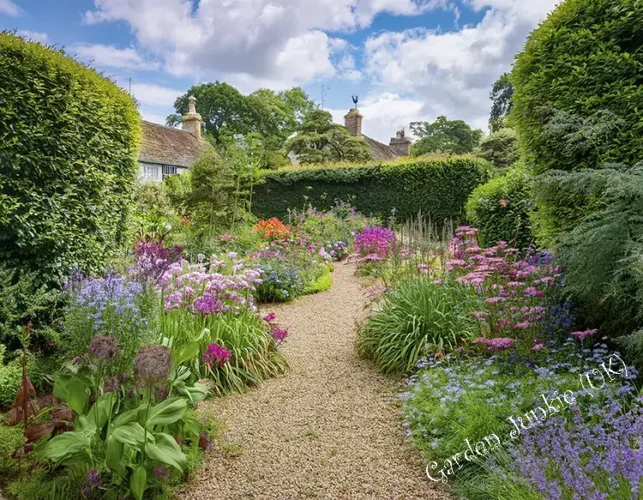
Choose Your Gardening Month by Month –
Gardening Month by Month – In July, as set out every month for our readers, we continue our regular monthly gardening section, which hopefully provides practical, informative checklists and reminders to help guide you through various gardening tasks for each month of the gardening calendar.
This page Gardening Month by Month – July like other similar monthly pages continues to offer helpful reminders and tips for tending to your garden, allotment, greenhouse, pond, and general garden maintenance.
Many of these gardening activities are tailored to specific months or even certain types of gardens, therefore not all tips and information may be useful. However, on this page, we looked at what tasks may require your focus in and around the garden, allotment, pond and greenhouse during July.
Gardening Month by Month – July (Quick Tips)
July is a month for reaping the rewards of your year’s gardening efforts. The summer sun is in full force (hopefully), so it’s essential to keep plants well-hydrated, especially those in containers. Deadheading your flowers regularly will encourage continuous blooming. This is also the time to enjoy the fruits of your labour with ripe strawberries, raspberries, and currants. Don’t forget to check for pests and diseases, as warm weather can create ideal conditions for them to thrive.
Vegetable patches will be thriving in July. Keep up with harvesting to prevent over-ripening. Consider sowing a final batch of fast-growing crops like lettuce or radishes for an autumn harvest. Regular watering and feeding are essential to maintain productivity. For those with fruit trees in containers or the ground, thin out excess fruit to ensure larger, sweeter produce.
Lawn care is crucial in July. While it may go dormant in hot spells, regular mowing and watering will help maintain its health. Keep an eye out for weeds and diseases, treating them promptly. This is also a good time to prepare for autumn by aerating the lawn and overseeding bare patches.
In July: Garden, Allotment, Flowers, Greenhouse.
July is a spectacular month for flowers. Roses, lilies, and delphiniums dominate the borders. Deadheading is essential to prolong flowering. For continued colour, sow hardy annuals like cornflowers and calendulas. Keep containers well-watered, especially during hot spells. As we shall see below consider planting autumn-flowering bulbs for a seamless transition to the next season.
Water thoroughly, especially containers and new plantings. Continue feeding hungry plants to maintain their vigour. For the adventurous gardener, July is the time to start sowing hardy annuals for autumn colour.
Allotments in July are a gardener’s paradise. Harvest regularly to encourage continued production of vegetables such as peas, beans, and courgettes. Protect crops from pests and continue sowing fast-maturing varieties for a late harvest. Keep the soil moist but not waterlogged, especially for root crops. As the season progresses, start planning your autumn crops and rotation.
Yellow card sticky traps are a valuable, low-cost tool for monitoring the numbers and types of ‘flying pests’ in the greenhouse. If a large number of a particular pest is detected, appropriate treatment can be initiated.
Checkout Our July Gardening Checklist:
- Though we are enjoying the fruits of our labour in July, it is also the time to think ahead to the autumn and winter. You can begin planting Autumn-flowering bulbs like nerine, crocuses, colchicum (naked ladies), and sternbergia. These will provide colour and interest to your garden later in the year.
- In July, many hardy annuals can also be ‘sown’ outdoors like Nigella (Love in a Mist) in rows around 12in – (30 cm) apart. Another popular choice is Calendula (Calendula officinalis) or Pot Marigolds as they are often called, which is a great ‘companion plant‘ for the garden, as they attract bees and other pollinating insects as well as beneficial insects which will help to reduce pests such as aphids.
- In July you can still plant biennials like foxgloves, (Digitalis) honesty, forget-me-nots, (Myosotis sylvatica) and wallflowers (Erysimum) now to enjoy blooms next year.
- Continue to regularly hoe and hand-weed the borders to prevent weeds from maturing and producing seeds.
- Try trimming back plants in your ‘hanging baskets’ and then fertilising them. This can stimulate new growth and rejuvenate tired, lacklustre displays, giving a second flush.
- Generally, consistently feed, water, and deadhead summer bedding plants in pots, borders, and hanging baskets.
- Don’t forget your Roses! Fertilise and deadhead your roses regularly to ensure they continue to bloom vigorously.
- Continue to monitor for pests like lily beetles, snails, and aphids. Also, vine weevils, which can be a problem this time of the year, ensure you remove them promptly to prevent significant damage.
- The unexpected wilting of seemingly healthy clematis, particularly large-flowered varieties, may suggest clematis wilt. Remove the wilted stems, as new shoots could emerge from the base.
- Continue to mow lawns lightly but often to create ‘short’ clippings, these clippings should be left on the grass during hot weather to serve as a moisture-retaining mulch.
- Continue to make compost or start a compost bin. Aim to keep a balance between ‘green’ and ‘brown’ materials in your compost pile. During the summer months, the compost often contains a surplus of green ingredients, which are typically soft, rich in nitrogen, and may not always be green in colour which can lead to a lack of structure and reduced ‘airflow’ in the pile. Therefore, it’s essential to incorporate an equal amount of brown materials such as twigs, cardboard, and wood ash.
- Remember that plants in containers rely on you for their water, as they receive little benefit from rain. In sunny weather, make sure to give them a thorough soak at least once a day.
- Hard and softwood cuttings can be taken and grown in the greenhouse, with fuchsias and pelargoniums being excellent candidates for propagation.
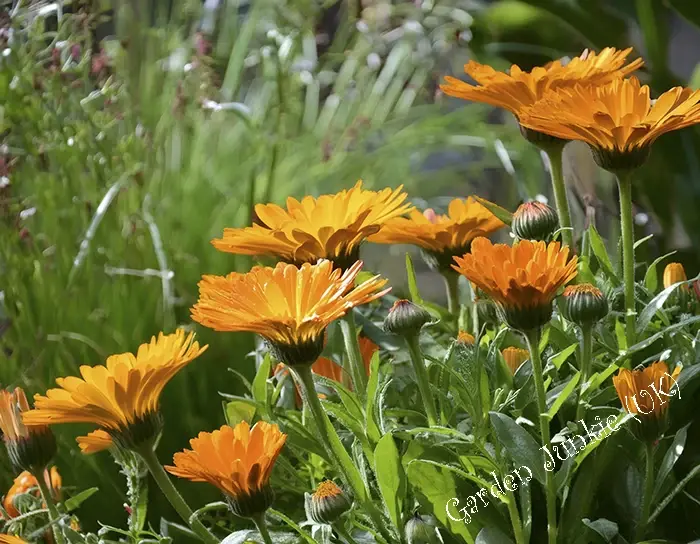
Gardening Month by Month – July: Calendula or Pot Marigolds Can Be Sown Outdoors This Month
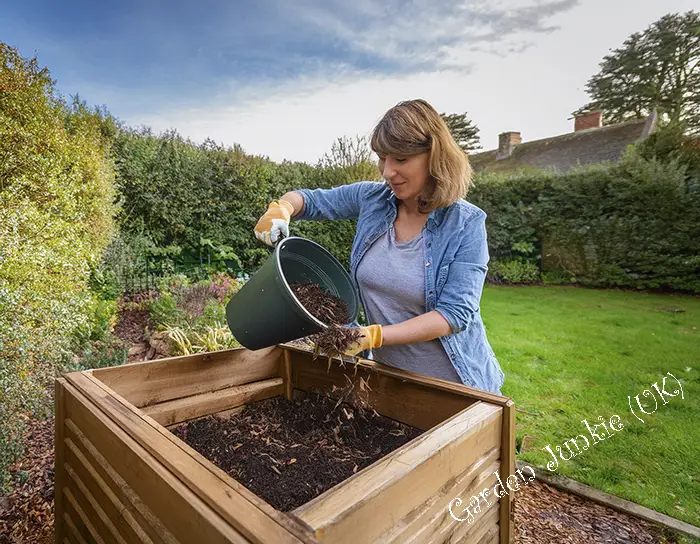
Gardening Month by Month – July: Ensure You Add Equal Amounts of Greens and Browns to Your Compost Bin
In July: Fruit & Veg
- Begin harvesting tomatoes as they ripen, and continue to remove any side shoots while ensuring the plants receive adequate feeding and watering.
- Many vegetables can be sown now to fill gaps left by cleared earlier crops, providing fresh produce throughout the autumn and winter. Ensure you complete the ‘sowing’ of any beetroot and savoy cabbage during the first week of July. To ensure a good harvest later in the year.
- July is the final month to sow carrots for an autumn harvest. Sow them directly and thinly into shallow drills of well-prepared soil or in pots filled with soil-based compost. To help prevent carrot fly, it’s best to avoid thinning the seedlings.
- Want winter radishes? Sow now in July. Radishes are quick to mature, easy to cultivate, and nearly pest-free, adding a peppery flavour to salads. Additionally, they can be grown as companion plants alongside other crops.
- Blackberries, early plums, gooseberries, raspberries, and blueberries should all be ripe for picking now. Harvest these fruits as soon as they are ready to prevent pests from exploiting them. Regular harvesting should also encourage the production of more flowers and fruits.
- This month, trained fruit trees should be pruned to remove unwanted shoots. This will allow good air circulation to reduce the risk of disease.
- Those of you who have ‘Corden’ fruit trees can start the Summer pruning of your Corden apples and pears to preserve their shape by shortening the side shoots that grow from the ‘cordon’ framework to five (5) leaves from their base.
- July is also an ideal time for pruning cherry, apricot, peach, and plum trees when the risk of ‘silver leaf disease’ is lower.
- Try ‘netting’ fruit trees that are at risk from birds and squirrels. For larger trees, like cherries, where it’s impractical to net the entire tree, you may consider protecting a few branches or a section while allowing birds to access the rest.
- Propagate additional strawberry plants for next year by ‘pegging down’ runners into the ground or pots of compost to encourage rooting. Additionally, if you or your friends and neighbours don’t need more plants, it’s best to remove the runners entirely.
- Cut back the growing tips of courgette and squash plants to promote branching.
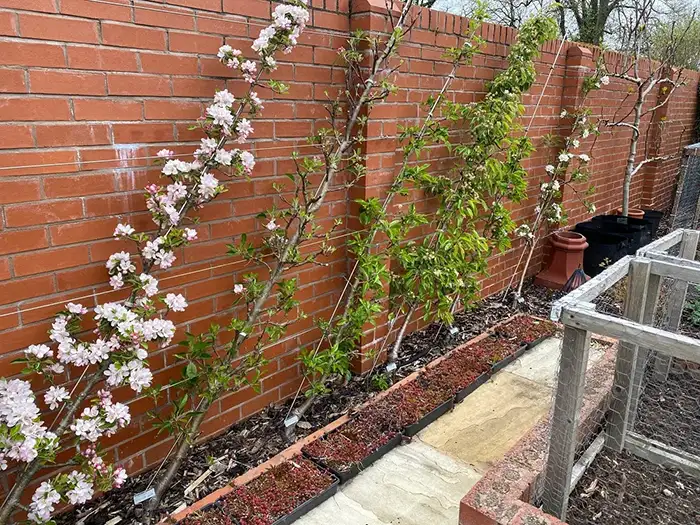
July is the time to prune ‘Corden’ Apple And Pear Trees

Gardening Month by Month – July: Harvest Tomatoes as They Ripen.
In July: Pond Care
July is a vital month for pond care in the UK, as rising temperatures lead to a thriving pond ecosystem. Focus on water quality by regularly checking oxygen levels, particularly at night.
Excessive algae growth can deplete oxygen, so consider adding aeration if needed. Monitor your fish closely, as warmer temperatures can boost their metabolism and appetite; feed them a balanced diet and avoid overfeeding to prevent water pollution. Additionally, performing regular water changes can help maintain optimal water quality.
Plant growth will be vigorous in July, so anticipate flourishing aquatic plants. Prune any overgrown vegetation to prevent ‘shading’ and maintain a healthy balance. Consider adding new aquatic plants to enhance your pond’s beauty and biodiversity. Stay alert for pond snails and other pests that may harm your plants. Regularly removing debris, such as fallen leaves and twigs, is crucial to prevent water quality issues.
In Addition:
- Top up ponds and water features as needed. Using a ‘spray attachment’ on the hose will aerate the water, benefiting your fish.
- Help the garden wildlife. Fully developed larvae of damselflies and dragonflies will emerge from the water by ‘climbing’ up plant stems, where they shed their skins to transform into flying adults. If your pond lacks suitable plants, consider adding upright marginals like water iris.
- Watch for any yellowing leaves on water lilies and other aquatic plants. If you find them, remove them promptly, as allowing them to fall and rot in the water can decrease your water quality.
- Did you know? If your area is under a hosepipe ban, then you are exempt from the restriction if you have a fish pond. You can still use it to top up and maintain your pond provided it contains fish.
- Remember to remove blanket weed to allow oxygen to enter your pond. Use a net or rake, and be sure to pile the weed next to the pond for a day or two to give aquatic life a chance to return to the water.
- July is a time for friends and family to enjoy your outdoor space. Cover fish ponds with nets in gardens where young children play. This not only enhances safety but also helps prevent leaves and other debris from falling into the pond.
- With warmer temperatures and extended sunlight exposure, conditions for algae growth are ideal. Ensure that your UV bulb is functioning by checking it through your filter’s viewing window, preferably at night, when you should see a faint blue glow. If you can see the blue glow, it’s working well. If not, you may need to replace the bulb, which should be done after six months of continuous use anyway.
- Fish chasing each other is a clear sign of ‘spawning’ during this time of year. However, monitor them closely, as they may be less aware of predators and females can be driven into the shallows. This behaviour can lead to fish getting stranded or even pushed onto cover nets, and females may become exhausted from days of relentless chasing.
- Female fish can also become ‘egg bound’ so in a bare pond it’s a good idea to add some spawning brushes so that they can release their eggs annually as they would in the wild. The female’s skin can become thin and liable to damage from being ‘scraped’ on the pond walls. This ‘damage’ can open up the chances of secondary fungal infection for the fish.
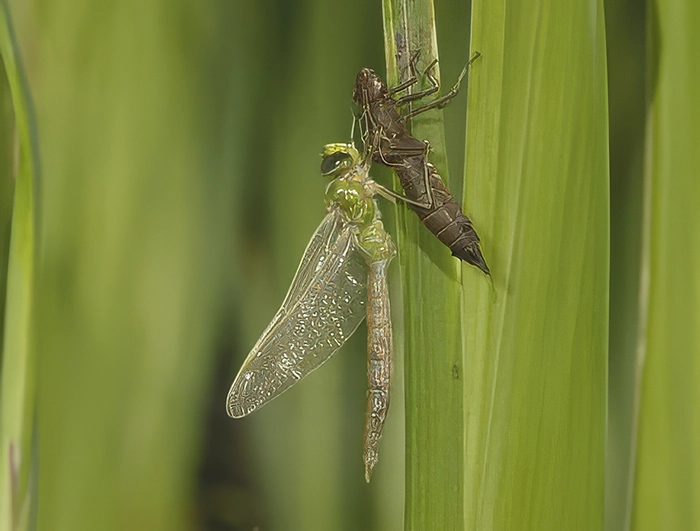
Gardening Month by Month – July: Fully Developed Larvae of Damselflies and Dragonflies Will Emerge From The Water by ‘Climbing’ up Plant Stems,
In July: General Garden Maintenance
July is an ideal time to address outdoor maintenance tasks that may have been postponed. Focus on enhancing your garden’s infrastructure by checking the condition of your fences, repairing any damaged panels, or replacing rotten posts.
Ensure that garden paths are clear of weeds and moss, and consider applying a fresh layer of gravel or path sealant to prevent erosion. Pay particular attention to gutters and drains; clear them of leaves and debris to avoid waterlogging and potential damage to your property, which will also help maintain a healthy flow during heavy rainfall.
Taking care of your garden’s hard landscaping now will save you time and effort later. Consider using pressure washers for cleaning patios and decking to remove algae and grime. Don’t forget about garden sheds and greenhouses; clear out any clutter and perform necessary repairs, like broken or loose door hinges. A well-maintained outdoor space will not only look great but will also be more enjoyable to use throughout the summer months.
- July is also the perfect time to give your wooden garden shed a facelift by applying a new coat of paint or preservative. Fences and garden furniture also regularly need new coats of paint or preservative.
- Prevent tall perennials from falling over in the wind by staking them. Try inserting a cane at the back, tie string to it, then loop it around the outer stems of the plant before returning to the cane and tying it off.
- Tidy up all fallen leaves, dead flowers, and scattered compost to prevent potential pest and disease problems.

Gardening Month by Month – July: Address Outdoor Maintenance Tasks Like Painting Your Garden Shed.
FAQ’s
Should I be worried about my lawn going brown in July, and what can I do about it?
It’s common for lawns to turn brown during hot, dry spells in July. While this can be alarming, many grasses are resilient and will recover with cooler weather and rain. To help your lawn, consider reducing mowing height, watering deeply but infrequently, and avoiding heavy foot traffic to minimise stress on the grass.
How can I encourage wildlife to visit my garden in July?
To attract wildlife in July, consider planting a variety of flowering plants that provide nectar and pollen for bees and butterflies. Incorporate native plants, as they are more likely to attract local wildlife. Additionally, create habitats by leaving some areas of your garden wild and installing bird feeders or water sources to encourage visits from birds and beneficial insects.
What unusual gardening tools should I consider using in July?
In July, consider using garden tools like a soil moisture meter to monitor watering needs accurately, especially during hot spells. A garden kneeler and seat can make weeding and planting more comfortable, while a hori-hori knife is versatile for digging, cutting, and weeding. These tools can enhance your gardening experience and efficiency.
